3D Telepresence Market Size
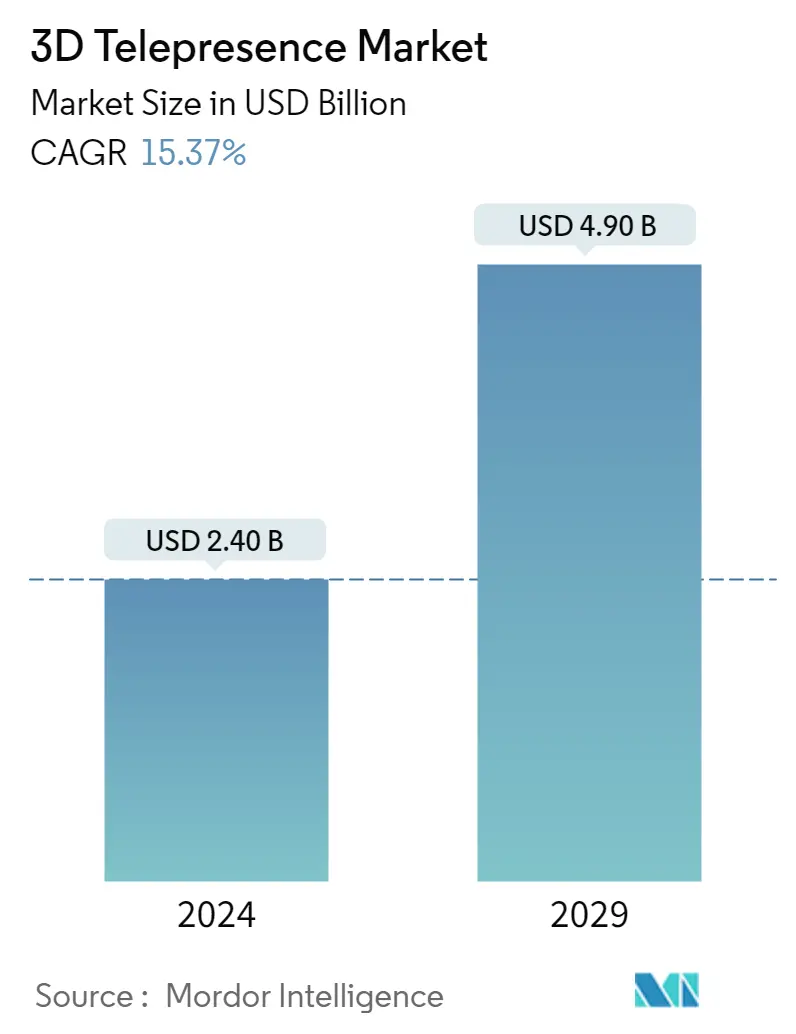
| Study Period | 2019 - 2029 |
| Market Size (2024) | USD 2.40 Billion |
| Market Size (2029) | USD 4.90 Billion |
| CAGR (2024 - 2029) | 15.37 % |
| Fastest Growing Market | Asia Pacific |
| Largest Market | North America |
Major Players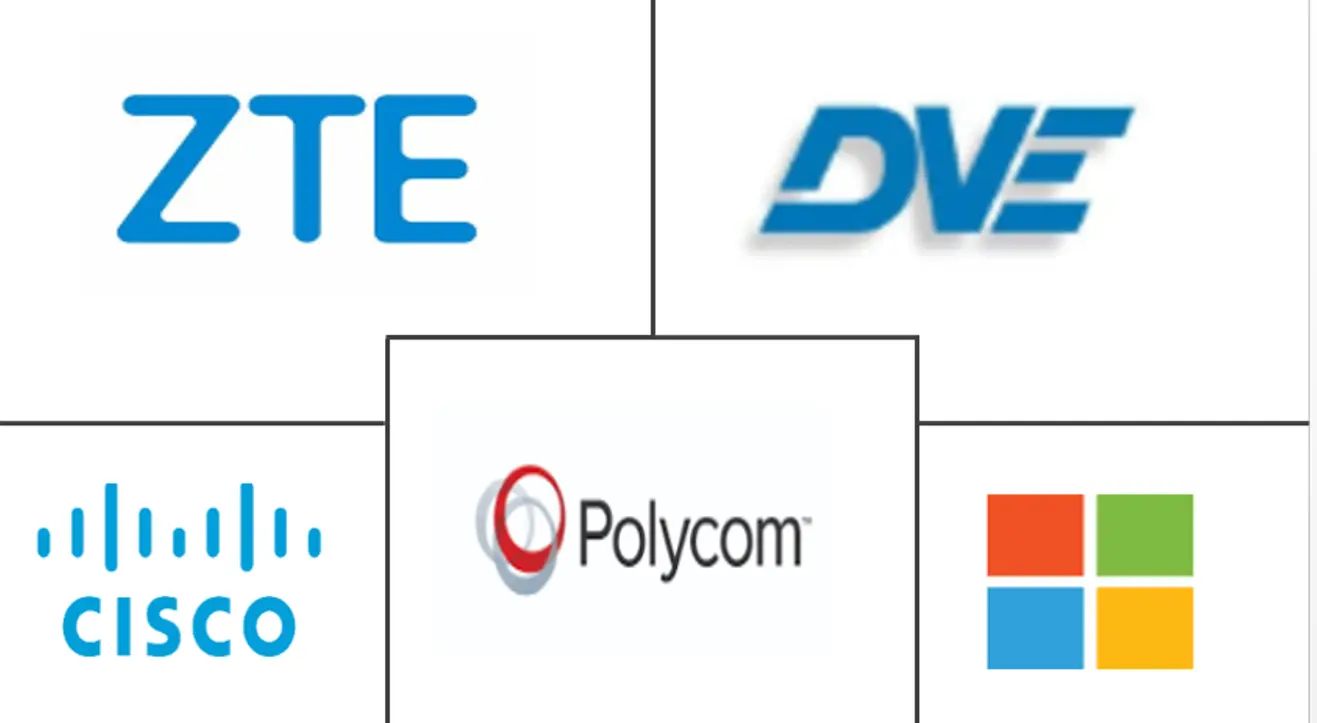
*Disclaimer: Major Players sorted in no particular order |
3D Telepresence Market Analysis
The 3D Telepresence Market size is estimated at USD 2.40 billion in 2024, and is expected to reach USD 4.90 billion by 2029, growing at a CAGR of 15.37% during the forecast period (2024-2029).
- The growing adoption of advanced technologies, such as AR and MR, is expected to pave the path for a new collaborative platform called 3D telepresence. The increasing adoption of advanced technologies, such as AR and MR, is expected to pave the way for a new collaborative platform called 3D telepresence.
- Audio and visual applications like Google Hangouts, Facetime, Skype, and other video conferencing platforms for offices exist today for use across enterprises to enable remote communication.
- Although the quality of experience, concerning audio and visual transmission, has significantly improved over the years, 2D video technology has several inherent drawbacks, like loss of non-verbal cues, such as eye contact and gestures, which cannot be mitigated easily. Some of these issues are addressed by 3D telepresence, which provides rendering and streaming of 3D video data between two or more parties, boosting the adoption of 3D telepresence globally.
- While intelligent conference rooms are being developed by companies like Cisco (Spark system), a bundle of cameras, 4K screen speakers, and supporting devices, technology advancements result in more life-like experiences through telepresence.
- Cisco, Microsoft, Teliris, Huwaei, and Sony are among the early entrants in the telepresence space. Since its inception, the technology has overcome a few challenges, such as interoperability between telepresence systems from different vendors and compatibility with networks provided by various telecom companies.
- The technology has been showcased in several entertainment demonstrations, like Musion 3D. However, to date, the practical applications have been limited by the high cost of such 3D systems compared to 2D telepresence/video conferencing.
- The remote consumer's digital representations could be rendered over the real by taking advantage of recent advances in augmented reality (AR), coupled with 3D, such as Atheer air Glasses, Google Glass, and Microsoft hololens world, creating a mixed-reality experience. Following the COVID-19 pandemic, trends such as remote working and the need for immersive experiences were expected to gain momentum. In such a regard, 3D telepresence systems were crucial in ensuring workflow.
3D Telepresence Market Trends
Enhanced User Experience is expected to Drive the Growth in software segment.
- The tele-immersion technology and 3D technology provide an increased presence for remote users, whether bundled with virtual or augmented reality (AR). Aside from enhancing the user experience in terms of communication, which is currently performed with 2D video conferencing, there is a potential use of this technology in several other areas that would reduce the need for travel.
- Moreover, applications, such as in remote collaboration, where multi-disciplinary teams have to work closely with 3D data or models, like in design, manufacturing, medicine, physical sciences, architecture, astronomy, digital humanities, and education, among various other applications, are expected to drive the demand for these solutions.
- Further, initiatives aimed at pushing the deployment of standard video conferencing to achieve real-world experience are driving the market growth. For instance, in the previous year, researchers from Facebook Reality Labs announced the development of a virtual telepresence system that utilizes photorealistic avatars to capture and convey the gaze and eye contact signals of social interactions in the real world.
- Statistical forecasts suggest that an organization could boost its productivity by up to 40% due to quick decision-making, saving travel costs and travel time because of the 3D telepresence systems.
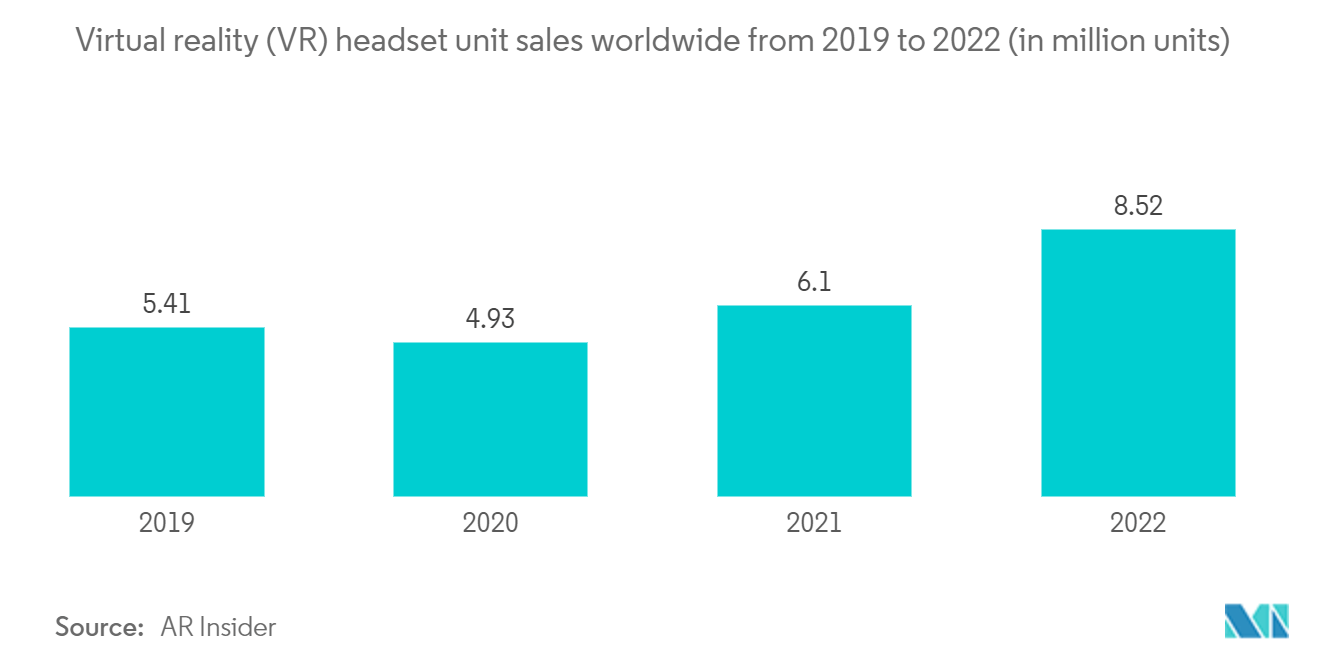
Europe to have a Dominant Share in the Market
- Various research studies are conducted to ensure an immersive experience in 3D telepresence systems. For instance, researchers from the De Montfort University in Leicester, United Kingdom, are working on a project to develop new algorithms that could reduce lossy compression of point clouds whose usage is widely observed in 3D telepresence.
- Compared to traditional video technology, 3D point clouds offer various advantages, such as free-viewpoint rendering and a mix of natural and synthetic objects. The EU-funded OPT-PCC project is developing new data compression algorithms to optimize the image rate-distortion performance with efficient compression methods that could increase storage capability and improve bandwidth usage.
- The growing adoption of advanced technologies, such as AR and MR, is expected to pave the path for increased adoption of the 3D telepresence market.
- As part of its industrial development strategy, the United Kingdom government announced an investment of EURO 400 million (USD 433.28 million) the previous year to back cutting-edge R&D projects across the country, covering immersive technologies like AR, VR, and MR. Such investments are expected to increase opportunities for United Kingdom-based businesses to create new apps, tools, and virtual experiences.
- Mixed reality (MR) based startups regularly attract investors' funds for product innovations to seize market growth opportunities. For instance, Zapper announced raising investments for its MR device. The startup recently released the next version of its app.
- Similarly, the previous year, Hyper, a London-based startup, created an innovative Mixed Reality (MR) co-design platform that addresses the bottleneck. Hyper has introduced a spatial design platform that can successfully merge VR with physically accurate, motion-tracked models, owning to the EIT Digital-supported "HyperCRC" innovation activity.
- Moreover, Hyper provides a spatial design platform that combines VR with real-world motion-tracked models. The company offers a standard design package that allows customers to choose from 40 different materials and customize four objects within four immersive 3D environments. Furthermore, the technology enables the company's clients to collaborate and co-design remotely.
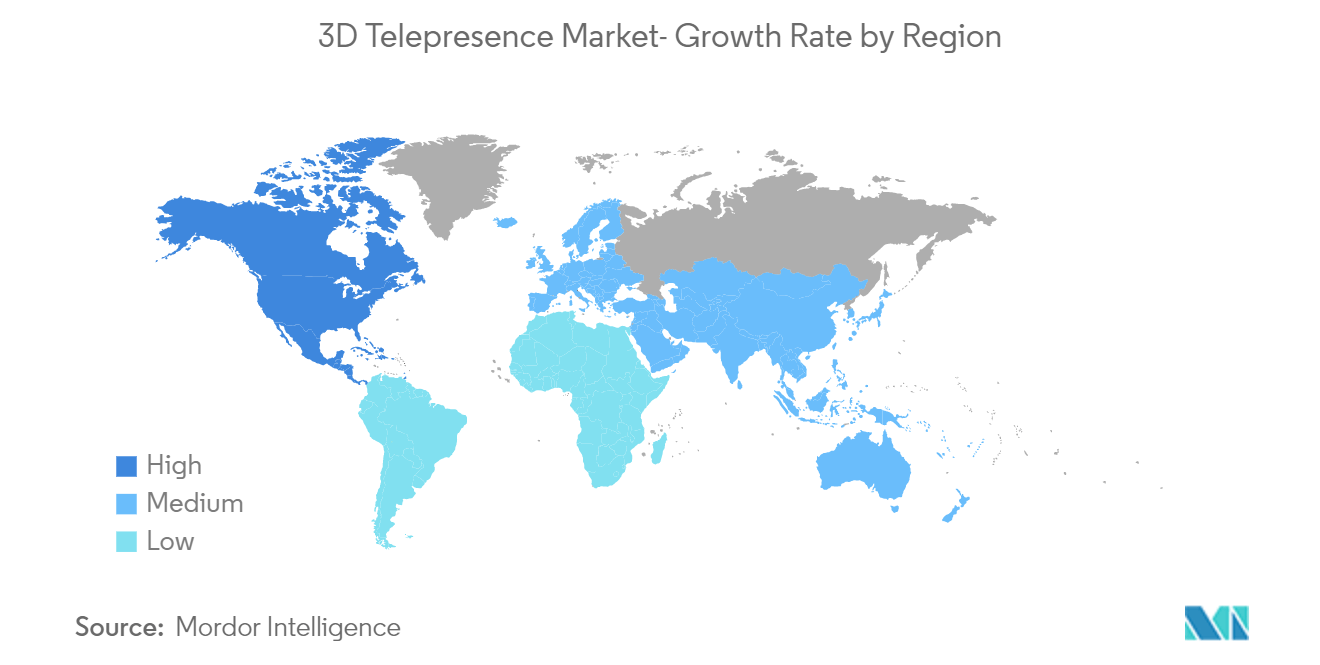
3D Telepresence Industry Overview
The 3D Telepresence Market is Highly fragmented due to the presence of a large number of players. Major players in the market include TelePresence Tech, Cisco Systems Inc., Microsoft Corporation, Teliris, Inc. (Dimension Data), Digital Video Enterprises Inc., Musion, Polycom Inc., and ZTE Corporation. Some key recent developments in the market are as follows:
In November 2022, Inbiodroid, a Mexican startup, launched a Kickstarter campaign to fund the second version of its telepresence avatar robot. The company's mission was to break down the physical barriers that limited humanity's industrial progress and ushered in a new era in which growth and advancement were not limited by space or time.
Moreover, PROMETHEUS 2.0, the most advanced Avatar robot with telepresence technology, is a humanoid robotic body capable of replicating its user's movements in real-time from anywhere in the world. Using a completely new AVATAR SYSTEM PROTOTYPE - with advanced features currently in development - users can transfer their awareness, skills, movements, and intentions to PROMETHEUS 2.0 via an immersive platform and an active communication interface.
In February 2022, Cisco rolled out a photorealistic real-time remote telepresence feature for Webex Hologram, its teleconferencing service that was slowly rolling out with a handful of clients since October 2021. The new service uses a camera array and a HoloLens or Magic Leap AR head-mounted display.
3D Telepresence Market Leaders
-
Microsoft Corporation
-
Cisco Systems Inc.
-
ZTE Corporation
-
Digital Video Enterprises Inc.
-
Polycom Inc.
*Disclaimer: Major Players sorted in no particular order
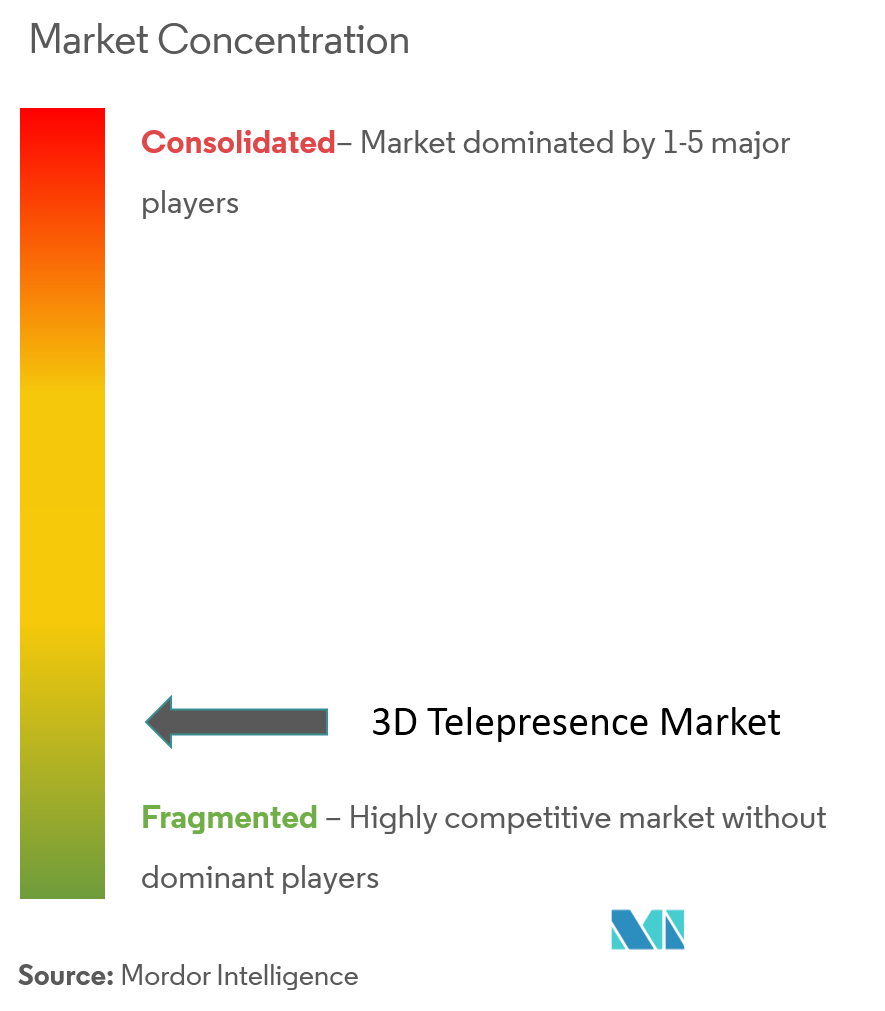
3D Telepresence Market News
- March 2023: DVE granted a landmark patent for Transparent LCD Holographic Streaming and Videoconferencing. DVEholographics announced the issuance of US Patent #11,258,983, which claims priority of all transparent LCD live interactive broadcast streaming, including all videoconferencing using applications such as Zoom, Webex, and Teams. The patent claims dozens of configurational uses, including portrait displays with standing life-size holographic participants and replacing millions of standard videoconferencing rooms.
- March 2022: ZTE launched a 50G PON prototype. ZTE Corporation, a global provider of internet telecommunications, enterprise, and consumer technology solutions, has unveiled the world's first precise 50G PON prototype. The release is a significant step forward in exploring 50G PON application scenarios, advancing 50G PON technology, and transforming the 50G PON industry chain. The precise 50G PON prototype has ultra-high bandwidth, low latency, and low jitter. It allows it to provide ultra-high bandwidth access for homes and businesses, support mobile xHaul, and implement deterministic campus networking.
- April 2022: NASA used 3D telepresence tech 'holoports' people to (and soon from) space. The NASA press release is just one example of how holoportation technologies, which use 3D capture and mixed reality displays to evoke social presence, can be used. The release describes an impressive demonstration of holoportation to the International Space Station while traveling "17,500 miles per hour in orbit 250 miles above Earth" and says that plans include enabling two-way haptic holoportation during deep space missions to/from extreme remote environments on Earth.
3D Telepresence Market Report - Table of Contents
1. INTRODUCTION
- 1.1 Study Assumptions and Market Definition
- 1.2 Scope of the Study
2. RESEARCH METHODOLOGY
3. EXECUTIVE SUMMARY
4. MARKET DYNAMICS
- 4.1 Market Overview
- 4.2 Introduction to Market Drivers and Restraints
-
4.3 Market Drivers
- 4.3.1 Enhanced User Experience
- 4.3.2 Increasing Demand For Time-Saving Technologies In Organizations
-
4.4 Market Restraints
- 4.4.1 High Costs And Limited Commercialization
- 4.5 Industry Value Chain Analysis
-
4.6 Industry Attractiveness - Porter's Five Forces Analysis
- 4.6.1 Bargaining Power of Buyers/Consumers
- 4.6.2 Bargaining Power of Suppliers
- 4.6.3 Threat of New Entrants
- 4.6.4 Threat of Substitute Products
- 4.6.5 Intensity of Competitive Rivalry
- 4.7 Impact of COVID-19 on the Market
5. MARKET SEGMENTATION
-
5.1 Solution Type
- 5.1.1 Software
- 5.1.2 Hardware
-
5.2 Application
- 5.2.1 Education
- 5.2.2 Advertising
- 5.2.3 Conferencing
- 5.2.4 Customer Service
- 5.2.5 Other Applications
-
5.3 Geography
- 5.3.1 North America
- 5.3.2 Europe
- 5.3.3 Asia-Pacific
- 5.3.4 Latin America
- 5.3.5 Middle East and Africa
6. COMPETITIVE LANDSCAPE
-
6.1 Company Profiles*
- 6.1.1 TelePresence Tech
- 6.1.2 Cisco Systems Inc.
- 6.1.3 Microsoft Corporation
- 6.1.4 Holoxica Limited
- 6.1.5 Valorem Reply
- 6.1.6 Teliris Inc. (Dimension Data)
- 6.1.7 Digital Video Enterprises Inc.
- 6.1.8 Musion 3D
- 6.1.9 Polycom Inc.
- 6.1.10 ZTE Corporation
- 6.1.11 MDH Hologram Ltd.
- 6.1.12 Primasonic Spectrum Private Ltd.
7. INVESTMENT ANALYSIS
8. MARKET OPPORTUNITIES AND FUTURE TRENDS
** Subject To Availablity3D Telepresence Industry Segmentation
3D TelePresence achieves actual depth without the usage of 3D glasses. An individual from a different part of the world can appear life-size inside the space for real-time two-way dialogue while maintaining eye contact.
Moreover, this technology is the emergence of new communication techniques. Consulting firms widely use this to provide personalized service to their clients that cannot be provided by phone, email, or any other standard video. It is capable of bringing renowned specialists from multiple countries at the same time. The scope of the market includes Solution Type Hardware and Software, applications including Education, Advertising, Conferencing, and Customer Service, among others.
The 3D Telepresence Market is Segmented by Solution Type (Hardware and Software), Application (Education, Advertising, Conferencing, Customer Service), and Geography (North America, Europe, Asia-Pacific, South America, Middle East, and Africa). The market sizes and forecasts are valued in USD for all the above segments.
| Solution Type | Software |
| Hardware | |
| Application | Education |
| Advertising | |
| Conferencing | |
| Customer Service | |
| Other Applications | |
| Geography | North America |
| Europe | |
| Asia-Pacific | |
| Latin America | |
| Middle East and Africa |
3D Telepresence Market Research FAQs
How big is the 3D Telepresence Market?
The 3D Telepresence Market size is expected to reach USD 2.40 billion in 2024 and grow at a CAGR of 15.37% to reach USD 4.90 billion by 2029.
What is the current 3D Telepresence Market size?
In 2024, the 3D Telepresence Market size is expected to reach USD 2.40 billion.
Who are the key players in 3D Telepresence Market?
Microsoft Corporation, Cisco Systems Inc., ZTE Corporation, Digital Video Enterprises Inc. and Polycom Inc. are the major companies operating in the 3D Telepresence Market.
Which is the fastest growing region in 3D Telepresence Market?
Asia Pacific is estimated to grow at the highest CAGR over the forecast period (2024-2029).
Which region has the biggest share in 3D Telepresence Market?
In 2024, the North America accounts for the largest market share in 3D Telepresence Market.
What years does this 3D Telepresence Market cover, and what was the market size in 2023?
In 2023, the 3D Telepresence Market size was estimated at USD 2.08 billion. The report covers the 3D Telepresence Market historical market size for years: 2019, 2020, 2021, 2022 and 2023. The report also forecasts the 3D Telepresence Market size for years: 2024, 2025, 2026, 2027, 2028 and 2029.
3D Telepresence Industry Report
Statistics for the 2024 3D Telepresence market share, size and revenue growth rate, created by Mordor Intelligence™ Industry Reports. 3D Telepresence analysis includes a market forecast outlook to for 2024 to 2029 and historical overview. Get a sample of this industry analysis as a free report PDF download.



